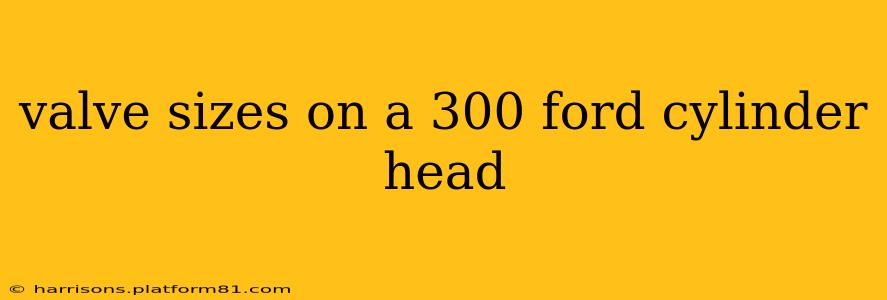The Ford 300 cubic inch inline-six engine, a workhorse known for its durability and reliability, has seen variations in valve sizes across its production lifespan. Pinpointing the exact valve sizes for your specific 300 Ford cylinder head requires knowing the year of manufacture and potentially the specific casting number. This guide will help you understand the variations and how to find the precise information you need.
What Determines Valve Size on a Ford 300?
Several factors influence the valve sizes used on a Ford 300 cylinder head:
- Year of Manufacture: Ford made adjustments to engine specifications over the years the 300 was in production. These changes sometimes included valve size alterations.
- Engine Application: The intended application (truck, car, etc.) could also impact valve sizes. Higher-performance applications might have larger valves.
- Casting Number: The casting number located on the cylinder head itself is the most definitive way to identify the precise specifications, including valve sizes. This number is crucial for accurate parts identification.
How to Find the Valve Sizes for Your Ford 300 Cylinder Head
The most reliable way to determine your valve sizes is by:
-
Locating the Casting Number: This number is usually stamped on the head itself, often near the spark plug holes or on a flat surface. Clean the area thoroughly if necessary.
-
Using an Online Parts Catalog or Database: Once you have the casting number, you can use online resources like parts websites or Ford-specific forums to look up the specifications. Many databases allow you to search by casting number to find detailed information, including valve sizes.
-
Checking a Ford Repair Manual: A factory service manual specific to the year and model of your engine will provide detailed specifications, including valve sizes.
Common Valve Sizes on Ford 300 Cylinder Heads (Approximate)
While precise sizes vary, you'll typically find intake valves in the range of 1.625 inches and exhaust valves around 1.375 inches on many Ford 300 heads. However, these are approximations, and you should never rely on these figures for parts ordering. Always confirm using your casting number.
What if I Can't Find the Casting Number?
If you're unable to locate the casting number, you can try:
- Checking Engine Identification Numbers: Other engine identification numbers might offer clues to the year and model, which can then be used to narrow down potential valve sizes.
- Comparing to Known Good Heads: If you have access to another verified Ford 300 head with known valve sizes, you could physically compare them, but this is not recommended unless you are certain of the other head's specifications.
Frequently Asked Questions
What are the consequences of using the wrong valve size?
Using incorrect valve sizes can lead to a range of problems, including poor engine performance, reduced power, and potential damage to the engine valves, seats, and even pistons if the valves interfere with the piston crowns. It's crucial to use the correct sizes.
Can I increase valve size for better performance?
Yes, increasing valve size can increase airflow, potentially leading to performance gains. However, this often requires significant modifications, including porting and polishing the head, and may necessitate other upgrades to the engine's intake and exhaust systems. This is a significant undertaking and should only be performed by experienced engine builders.
Where can I buy replacement valves?
You can purchase replacement valves from various automotive parts suppliers, both online and in brick-and-mortar stores. Always ensure you are ordering valves with the correct specifications for your specific Ford 300 cylinder head. Again, the casting number is critical!
This guide provides a comprehensive overview of finding valve sizes for your Ford 300 cylinder head. Remember, accuracy is paramount when dealing with engine components. Always verify the information you find with multiple sources and use your engine's casting number as your primary reference point.
